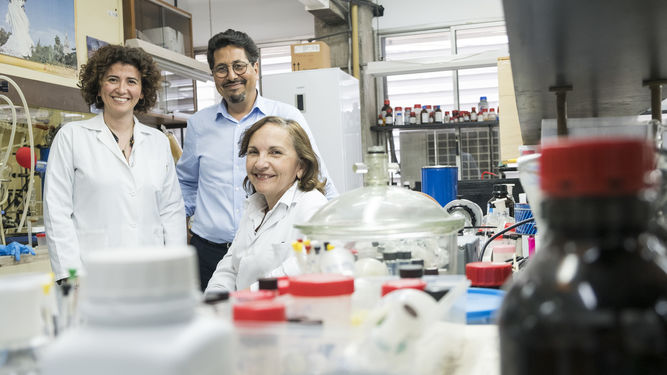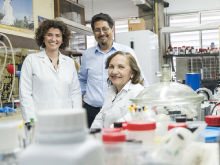Source: Diario de Sevilla
Hippocrates, for many the father of Medicine, already warned in the year 400 before Christ: “Let food be thy medicine and medicine be thy food.” It is no myth that food has the power to preserve health and prevent disease. It has been proven that broccoli, in addition to cauliflower, wasabi and the rest of the vegetables of the cruciferous family, have a molecule, sulforaphane (SFN), which is considered by the National Cancer Institute of the United States as one of the 40 most promising anti-cancer agents. However, the amount of SFN that broccoli presents is very small and it would be necessary to eat huge quantities of this vegetable for it to be effective, and also raw, since heat and other applications can degrade the compound.
A group of researchers from the Faculty of Pharmacy of the University of Seville, led by Professor Inmaculada Fernández, in In collaboration with another group from the Institute of Chemical Research (IIQ) of the Spanish National Research Council (CSIC), headed by Noureddine Khiar, current director of the IIQ, the team has gone even further and has managed to synthesize new compounds with anti-cancer properties and create, using this anti-cancer molecule from broccoli as a base, analogues of sulforaphane, and even improve the characteristics of the original.
This discovery – which was made possible thanks to the granting of a Project of Excellence by the Andalusian Government funded with more than 200,000 euros – was patented in 2012 by the University of Seville and the CSIC. After its publication in a scientific journal, the British company Evgen Pharma showed great interest in the new synthesized compounds, so much so that it bought the patent and has had its exclusivity since 2015.
The research was funded in 2012 by the Junta with 200,000 euros
SFN is currently the greatest natural inducer of phase II detoxification enzymes, inhibits phase I metabolism and is capable of regulating gene expression via epigenetics through multiple mechanisms. “All of this makes it one of the epigenetic agents with the greatest potential in the future treatment of multiple diseases,” explains Professor Inmaculada Fernández, director of the Department of Organic and Pharmaceutical Chemistry at the Hispalense and head of the Stereochemistry and Asymmetric Synthesis group at the Faculty of Pharmacy.
Despite the potential of SFN, at the moment, no medicine formulated with this active ingredient is available. “What is sold on the market related to SFN is based on broccoli extracts, anti-aging creams or dietary concentrates that are not so effective,” says Rocío Recio, a professor at the Faculty of Pharmacy who has also participated in the project.
According to Dr. Recio, one of the main reasons that prevents any pharmaceutical preparation containing the original SFN compound from being marketed is that it is very unstable and susceptible to being degraded by the action of oxygen, heat and alkaline conditions, losing its effectiveness. “The compound that we have managed to synthesize overcomes this barrier, is more stable and has a high bioavailability,” she comments.
“Our research focuses on the synthesis of chiral compounds. We develop methodologies to be able to prepare compounds with a certain stereochemistry (spatial arrangement of the atoms), since this can make a compound have or not a certain therapeutic activity,” comments Dr. Inmaculada Fernández. “This work has allowed us to get to where we are now and create SFN analogues. What’s more, not only have we been able to prepare this molecule and similar ones, but we have been able to improve the characteristics of the original.”
“The amount of SFN found in broccoli is very small, unstable and when the food is boiled, 90% of its effectiveness is lost, among other aspects,” adds Professor Recio. “We have managed to overcome all these drawbacks.”
SFN and its analogues are credited with numerous preventive and curative properties. In addition to preventing diseases, they protect against ultraviolet radiation, asthma, allergic rhinitis and chronic obstructive pulmonary disease, and can be used in the treatment of breast, skin, prostate, colon, gastric and liver cancer, among others, as well as preventing cardiovascular diseases, diabetes, skin aging, bacterial infections or atopic diseases. Recently, it has also been shown that SFN is able to cross the blood-brain membrane and exert a protective effect on the central nervous system. This has allowed the beginning of its application in the treatment of Parkinson’s disease, Alzheimer’s disease and autism.
Another patent from this group at the University of Seville
These scientists from the University of Seville and the CSIC have had a second patent since 2015, entitled NK1 receptor antagonists derived from carbohydrates, method of obtaining and medical use, the result of research that began in 2007 with the granting of a Research Project of Excellence from the Junta de Andalucía.
“NK1 receptor antagonists prevent the action of a peptide (set of amino acids) called substance P that is synthesized in the body naturally. Everyone has this substance P in their body,” explains Professor Rocío Recio. “When certain diseases occur, such as anxiety, depression, psoriasis, cancer, Parkinson‘s or simply pain, it has been proven that there is an increase in substance P, which, when it binds to its receptor, causes a series of pathologies. If we use an antagonist to this substance P you can avoid the harmful effect it has on the body.”
SFN and its analogues are credited with numerous healing properties
According to Fernández and Recio, there are currently only three antagonists to substance P on the market and they are prescribed to prevent nausea caused by chemotherapy in cancer patients. “However, it has been seen that the active ingredient in these drugs, Aprepitant, has anticancer properties when the dose is increased and also has activity against anxiety and depression, but synthesizing this molecule in a stereoselective manner is very difficult and expensive.”
The teams of doctors Fernández and Khiar have managed to synthesize Aprepitant analogues that act selectively, preferentially affecting cancer cells and not healthy ones, and from very cheap raw materials, such as carbohydrates. This study was carried out in collaboration with the research group of Professor Miguel López Lázaro, from the Department of Pharmacology at the University of Seville, who carried out in vitro tests, applying the new products synthesized in cancer cells. These new products have been tested on cell lines of lung, breast and skin cancer, with positive results.
From test tubes to the pharmaceutical industry
The British company Evgen Pharma has had the exclusive patent for sulforaphane analogues synthesized by researchers at the University of Seville and the CSIC since 2015, although the Andalusian institutions continue to be linked to it in some way. This pharmaceutical company has clinical trials underway with patients with metastatic breast cancer and subarachnoid hemorrhage (related to cerebral ischemia). In addition, it carries out preclinical research in cases of prostate cancer and multiple sclerosis. “We don’t know what results they are getting thanks to our product, but we believe they are good, since they have applied for patent protection in China and Japan,” explains Professor Inmaculada Fernández. This patent is already protected in Europe, the USA and Australia.




